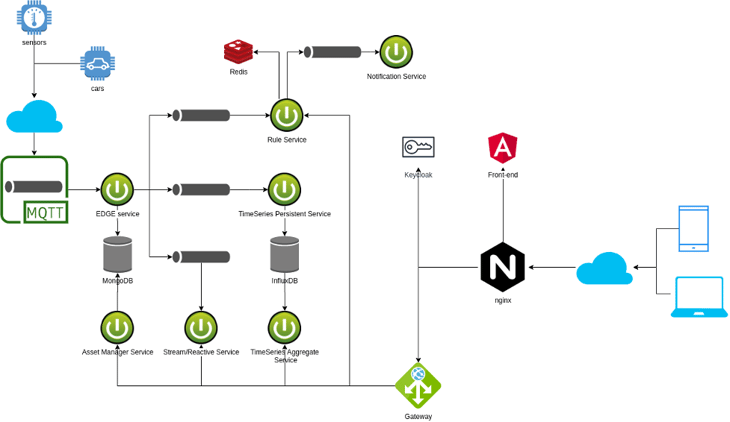Internet of Things is riddled with the challenges of managing heterogeneous equipment and processing and storing large masses of data. Businesses can solve many of the problems by building IoT in a scalable and flexible cloud architecture. The major cloud vendors - AWS, Microsoft Azure, and GCP - provide high-performance capabilities for such cloud architectures.
The Cloud Native Approach
Cloud-native approach involves building and managing applications that leverage the benefits of the cloud computing delivery model. So, it's a question of knowing how to create and deploy applications, not where. Thus, these applications can be delivered in both public and private clouds.
The cloud-native approach, defined by the CNCF, is characterized by microservices architectures, container technology, continuous deliveries, development pipelines, and infrastructure expressed in code (Infrastructure as a Code), an essential practice of the DevOps culture.
 Critical Aspects of an IoT Architecture
Critical Aspects of an IoT Architecture
An IoT infrastructure has three major components:
• A park of fixed or mobile connected objects, distributed geographically
• A network that allows objects to be connected by transmitting messages; it can be wired or short wireless (Wi-Fi, Bluetooth, etc.) or long-range, mobile (2G, 3G, 4G, 5G, etc.)
• An application, most often developed in web technology that collects data from the network of objects to provide aggregated and reprocessed information.
Ingestion System: Data ingestion system is at the core of the architecture as it is mostly responsible for consuming data from assets (sensors, cars, and other IoT devices), validating the data and then storing the data in a specified database. The ingestion system receives data using the MQTT protocol. The MQ Telemetry Transport is a lightweight protocol, simple and capable of functioning in networks with limited bandwidth and high latency.
Reporting: This component is fundamentally responsible for showing/generating information about the assets and transmitting out alerts about them. It is best to split the reporting into three services: time series aggregation offline, stream time series online, and rules service (system triggers). Time series aggregation service offline queries the data of the assets. Stream time-series online monitors in real-time the activities of a given asset. The rule service will alert the asset owner whenever a rule is triggered by SMS or email.
Embedded system: The embedded system's role is to transmit data from IoT devices to Edge / Ingestion Service. Each IoT device can send a JSON with assets (id, token, tenantId) to the Edge / Ingestion Service. Devices convey a JSON document to Edge / Ingestion Service with asset information (id, token, tenantId) from the embedded system.
Building an IoT-Ready Cloud Architecture
The gateway function: The Gateway function is the gateway for exchanging messages between the application and the park of objects. The first objective is to authenticate and authorize the objects to communicate with the application. The second objective is to encrypt the messages passing through the network to prevent them from being intercepted.
Message processing: Once the Gateway has been passed, it will be necessary to receive, process, and integrate the messages. Here the question of scalability is critical for seamless IoT cloud computing. This function must be able to absorb a highly fluctuating volume of messages. The success of an initial deployment can lead to a rapid expansion.
Park management: This function, internal as opposed to the data presentation application, must evolve at its own pace and independently from the rest of the application. Thus, it is good that it is designed as a separate module that can be updated without redeploying the entire application.
Database: The fleet of connected objects will feed the application with an increasing flow of data that will have to be stored, indexed, and analyzed. In this block, there must be relational databases and rapid databases of key-value types, indexing or search engine tools, etc. The security and integrity of data are critical. Being able to share databases between several front-end servers is essential to ensure the availability and scalability of the application. In terms of design, an N-tier architecture with an isolated database server is therefore essential. In particular, we could have an architecture that makes it possible to have a very short RPO (Recovery Point Objective) in the event of an incident.
Data virtualization: The objective of an IOT application is to process and present data to users who will connect to it, mainly via web access. The volume of connections to the application server will depend on its audience: limited for a professional application on a targeted audience, it can become significant on a general audience. In the latter case, it may be necessary to provide an auto-scaling system to add one or more servers in the event of load peaks and guarantee response times.
IoT devices can operate without a lot of resources upon connection to the cloud. Costs can be reduced, thus making IoT convenient for business usage. With the right architecture, the potential business value from your IoT implementation is invaluable.
Call us today, or better yet – click here to book a meeting.


